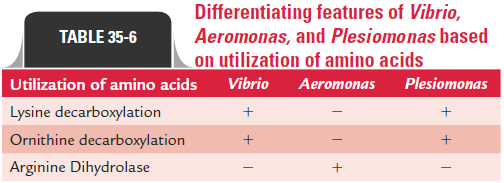Chapter: Microbiology and Immunology: Bacteriology: Vibrio,Aeromonas,and Plesiomonas
Plesiomonas
Plesiomonas
Plesiomonas species are oxidase-positive, Gram-negative, andfacultative anaerobes that are differentiated from genera Aeromonas and Vibrio of the family Vibrionaceae by some bio-chemical reactions (Table 35-6).
Plesiomonas shigelloides is the only species described in thegenus Plesiomonas. It is serologically related to Shigella sonnei and hence shows agglutination with S. sonnei antiserum. But it differs from Shigella by being oxidase positive and motile by the presence of polar flagella.

P. shigelloides is motile and Gram-negative rod with roundedends and measures 0.8–1 m. It is facultative anaerobe and grows well at 37°C. The bacterium produces nonlactose color-less colonies on MacConkey agar and nonhemolytic colonies on blood agar. It does not grow on TCBS agar. The bacterium ferments inositol with production of acid only, but does not ferment sucrose or starch.
The organisms are ubiquitous in fresh water and brackish water. The bacteria are frequently isolated from dogs, cats, goats, sheep, and other animals, such as frogs, snakes, turtles, and lizards. Humans acquire infection by ingestion of contami-nated seafood or contact with amphibians or reptiles.
P. shigelloides in humans causes gastroenteritis. The condi-tion occurs after 48 hours of ingestion of the organism. The condition manifests as mild and watery diarrhea with absence of mucus or blood in the stool. This is a self-limiting disease. The bacteria are also associated with uncommon extraintes-tinal infections, such as cellulitis, septic arthritis, septicemia, neonatal meningitis, etc.
P. shigelloides is resistant to ampicillin, erythromycin, andcarbenicillin but is susceptible to trimethoprim–sulfamethox-azole, chloramphenicol, cephalosporins, imipenem, and fluoroquinolones.
Related Topics